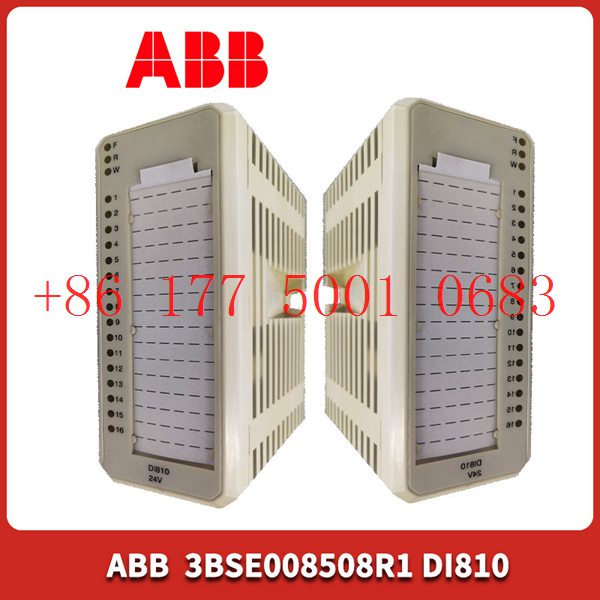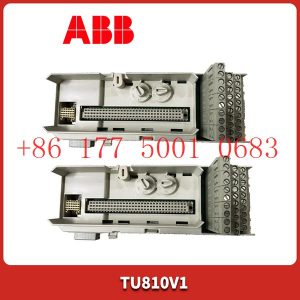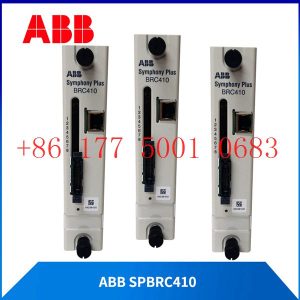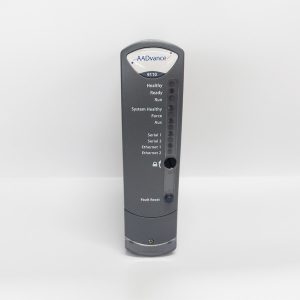Description
ABB DO810 module
Contact: Mr. Lai
Wechat:17750010683
Whats app:+86 17750010683
Skype:+86 17750010683
QQ: 3221366881
3221366881@qq.com
DCS PLC difference
In the thermal automation field of thermal power plants, DCS and PLC are two completely different and inextricably linked concepts. DCS and PLC are the combination of computer technology and industrial control technology. DCS is used for the host control system of thermal power plant, while PLC is mainly used in the auxiliary workshop of the power plant. Both DCS and PLC have operator stations to provide human-computer interaction, rely on computer technology based controllers to complete control operations, complete data exchange with primary components and actuators through I/O cards, and have communication systems called networks. DCS and PLC are so similar. Why do they have completely different concepts? How do we choose them in engineering practice? This paper summarizes the history, technical characteristics, development direction and other aspects, hoping to be useful for thermal engineering professionals. Take NETWORK6000+as an example to illustrate DCS in detail.
1. History and core concepts of DCS and PLC
DCS is the abbreviation of Total Distributed Control System. It refers to risk dispersion and data centralization. In the mid-1970s, it entered the market and completed analog control, replacing analog control instruments mainly based on PID operation. The idea of DCS was first proposed by instrument manufacturers, which were mainly used in the chemical industry at that time. PLC was successfully developed in the late 1960s, which is called Programmable Logic Controller (PLC) for logic operation. Mainly used in automobile manufacturing industry.
The design principles of DCS and PLC are quite different. PLC is developed by imitating the original relay control principle. In the 1970s, PLC only had switch logic control. It stores the instructions for performing logic operation, sequence control, timing, counting and operation; And through digital input and output operations, to control various types of machinery or production processes. The control program compiled by the user expresses the technological requirements of the production process. It is stored in the user program memory of PLC and executed one by one according to the content of stored program during operation to complete the operation required by the process flow.
DCS is developed on the basis of operational amplifier. All functions and relations between process variables are designed into function blocks. In the mid 1970s, DCS only had analog control.
The main difference between DCS and PLC controller is in the calculation of switching value and analog value. Even though they infiltrated each other later, they still have differences. After the 1980s, in addition to logic operation, PLC also added some control loop algorithms, but it is still difficult to complete some complex operations. PLC uses ladder diagram programming, and analog quantity operation is not intuitive in programming, which is troublesome. But in the aspect of solving logic, it shows the advantage of fast. DCS uses function blocks to encapsulate analog and logic operations. The expression forms of both logic operations and complex analog operations are very clear, but the expression efficiency of logic operations is lower than that of PLC.
The difference between DCS and PLC in history is obvious, which has a significant impact on their subsequent development. However, what has the greatest impact on the subsequent development is not the difference in the origin technology, but the difference in the origin concept. The core concept of DCS is a computer control system with decentralized hazards and centralized data. Therefore, the development process of DCS is to constantly use the latest achievements of computer technology, communication technology and control technology to build a complete distributed control system. DCS provides users with a complete, safe, reliable, efficient and flexible solution for industrial control. The core concept of PLC is programmable controller, which is used to replace relay, perform logic, timing, counting and other sequential control functions, and establish flexible program control device. Therefore, the main line of PLC”s continuous development is to constantly improve various capability indicators and provide users with a complete and flexible control device.
DCS is a system and PLC is a device, which is the fundamental difference between the two concepts. The influence of this difference is profound, and it permeates every aspect of the technological economy.
2. Technical characteristics and mutual penetration of DCS and PLC
Different concept bases and different development paths make DCS and PLC have different technical characteristics, and the development of technology is not closed. Mutual learning and mutual penetration also run through the development process.
2.1 Control processing capacity
As we know, a PLC controller can often handle thousands of I/O points (up to 8000 I/Os). The DCS controller can only handle hundreds of I/O points (no more than 500 I/Os). Is the technical level of DCS developers too poor? I”m afraid not. As far as the requirements of the distributed system are concerned, centralized control is not allowed. Controllers with too many I/O points are useless in practical applications. The DCS developers have never developed a driver for controllers with many I/O points. Their main focus is to provide the reliability and flexibility of the system. However, PLC is different. As an independent flexible control device, the stronger the point capacity is, of course, it means the higher the technical level. As for the application level of the entire control system, it is mainly the matter of engineers and users, not the core goal of PLC manufacturers.
Another indicator of control processing capacity, computing speed, is also much faster than DCS in people”s impression. From a certain point of view, this is indeed the case. The efficiency of PLC in performing logic operations is very high. The execution of 1K logic program is less than 1 millisecond, and its control cycle (taking DI input directly sent to DO output as an example) can be controlled within 50 ms; However, DCS adopts the same method when processing logic operation and analog operation, and its control cycle is often more than 100ms. When we compare the PID algorithm, we can find that the PLC executes a PID operation in a few milliseconds, while the T2550 controller of NETWORK6000+DCS also needs a millisecond to solve a PID. This shows that the PLC and DCS have the same computing capacity as the actual one, and the DCS controller of this model is even stronger. The difference in the control cycle is mainly related to the scheduling design of the controller. Large PLC often uses the sub CPU to complete the analog quantity calculation, and the main CPU completes the switching quantity calculation at a high speed. Therefore, even though the analog calculation speed is average, the speed performance in switching quantity control is excellent. However, DCS handles switching value and analog value calculation at the same speed, and the index of control cycle is really not ideal. The new DCS controller has learned the design of large PLC, and its performance in control cycle has been greatly improved. Take T2550 controller of NETWORK6000+DCS as an example. The controller can set four tasks with different priorities, and the minimum operation cycle can be set as 10ms. With high-speed I/O cards, the control cycle can reach 15~20ms. The analog quantity operation is set in other tasks with a long cycle.
2.2 Data communication exchange
Data communication exchange mainly refers to the control system network and its data exchange form. DCS has inherent advantages in this respect. The “dispersion” of the distributed system is mainly reflected in the independent controller, and the “centralization” is mainly reflected in the human-computer interaction device with complete data. It is the network that connects the dispersion and centralization into the distributed system. Therefore, since the early development of DCS, network has become the core technology direction of DCS manufacturers. Redundancy technology and narrowband transmission technology are the earliest developed or successfully applied by DCS manufacturers. PLC is mainly designed according to independent devices, and its “network” is actually serial communication.
The development and wide application of industrial Ethernet technology have formally smoothed the gap between DCS and PLC networks. On the surface, many DCS and PLC have applied industrial Ethernet, but there is still a gap in essence. Take MODBUS-TCP used by many PLCs as an example. MODBUS is a serial communication protocol, not a network, so we have no doubt; Is MODBUS-TCP a network? Many people have doubts. After careful analysis, MODBUS-TCP is a communication mode that loads the MODBUS communication protocol onto the TCP protocol of Ethernet. Although it has the appearance of a network, it is still a master and multi slave management mode, and a data table transmission structure. DCS, for example, takes ELIN network of network 6000+DCS as an example. Although it is also based on industrial Ethernet, its application layer protocol is a token free LIN network protocol that European companies have accumulated for nearly 30 years. It has long-term successful applications on 1M OLIN, 2.5M and 20M ARCNET. ELIN online, all stations are equal, and there is no main management station. Moreover, the data communication is structured data based on modules, and the data management ability is not comparable to that of data tables.
Take the PID module as an example. The basic data includes PV, SP and OP. If the data table transmission mode is used, you must first define the data addresses of PV, SP and OP as 01, 02 and 03. Other stations also receive data in the data table mode. But what data is 01? What data is 02? A data definition table must be used to restore. The management method of data tables is tedious and error prone. It is very terrible to use this method to manage tens of thousands of data points of a large system in the data table. While NETWORK6000+DCS is a structured management with modules as a unit. A PID is treated as a module. To access its PV value, first access its module and manage it in the form of PID.PV. In this way, all the tiled data are grouped into small boxes by module. The efficiency of management is greatly improved by means of component management.
The problem of PLC data communication exchange mainly stems from the development of PLC as an independent device for a long time, and there is no system concept; And it is mainly used in small control systems, and the problems are not obvious, so the development is slow. At present, some large PLCs have improved in this respect, but it still takes a long time to reach the level of DCS.
2.3 Configuration maintenance function
Configuration maintenance functions include logic configuration, download and modification, operation debugging, remote diagnosis, etc.
In the early days, PLC was dominated by ladder diagram, while DCS was dominated by module function diagram. After years of development, the International Electrotechnical Commission has specified five programming languages through the IEC1131-3 standard. At present, mainstream DCS and PLC all agree with this standard and support several or all of them. From the perspective of development efficiency and program readability, module function diagrams and sequential function diagrams have increasingly become the main programming methods, and ladder logic and structured text have become the development tools for user-defined modules. Large PLC is more and more like DCS in configuration mode, and the gap is gradually narrowing, while small PLC is still dominated by ladder diagram.
After years of development, DCS has accumulated a large number of advanced algorithm modules. For example, the device level module of NETWORK6000+has centralized the basic device oriented control and fault alarm functions in one module, which has also been transferred as a unit in network communication, greatly improving the efficiency of software development. A device pole module is equivalent to 0.5K ladder diagram logic quantity. It is much more complicated for PLC to complete the same function.
In terms of download, modification, operation debugging and remote diagnosis, PLC lacks solutions. From the beginning of the design, DCS started from the point of view of system needs, and has a perfect solution accumulated for many years. Taking NETWORK6000+DCS as an example, the system can not only modify the control strategy online, but also download the control strategy online. During the process of modification and download, the normal operation of the system will not be affected. NETWORK6000+DCS has perfect virtual DCS function, which can not only be used for the verification of configuration logic, but also be built into a complete virtual DCS to connect with the model and complete the simulation debugging of the system. NETWORK6000+DCS has perfect security measures and provides a wide area network based remote debugging scheme.
2.4 Hardware packaging structure
The PLC is generally a large bottom type rack and closed I/O module. The closed structure is beneficial to improve the reliability of I/O modules, and it is anti RF, anti-static and damage resistant. There are 8, 16 and 32 I/O points for PLC modules.
Most of the DCS are 19 inch standard chassis plus plug-in I/O modules, and the I/O modules are of exposed structure. There are 8 and 16 I/O points for each module, and 32 point modules are rarely used.
This structure of DCS stems from its use in large control objects. The 19 inch standard case is convenient for dense layout, and the less I/O points are due to the requirement of dispersion. The large bottom type frame and closed module structure of PLC are more flexible in management and configuration, and the reliability of single equipment is higher. Therefore, many DCS have also absorbed the advantages of PLC in structure and adopted a packaging structure similar to PLC, such as I/A using metal shell and NETWORK-6000+using conductive plastic shell.
2.5 Human computer interaction device
In the early days, DCS was a system, and its human-computer interaction device was a special device provided by the DCS manufacturer. However, PLC manufacturers generally do not provide human-computer interaction devices, and they often use general monitoring software (such as ifix, intouch, KingView) to complete them independently. The human-computer interaction device integrated with DCS often has more professional functions and better stability, but its price is also high. With the rapid development of PC technology, some general monitoring software developed rapidly, and its functions and performance gradually exceeded the special devices provided by DCS manufacturers. Therefore, many DCS manufacturers have gradually abandoned the dedicated human-computer interaction device, and have used the general monitoring software just like PLC. The use of general monitoring software by DCS manufacturers is not simply assembled, but based on the general monitoring software, through cooperative development, the network communication technology and system self diagnosis technology accumulated for many years have been retained and inherited in the form of special software packages.
For example, NETWORK-6000+used the T1000 human-computer interaction system based on a dedicated operating system in its early days, but now it mainly uses the T3500 human-computer interaction system based on FIX/FIX or INTOUCH. The LINPOLL network communication package is developed and integrated by Continental.
3. Market situation and development direction of DCS and PLC
In the field of thermal automation, DCS is basically used in the control system of the main plant without exception. PLC is only used in the auxiliary workshop. The main reason is that the early DCS system is very expensive, people think that the operation of the auxiliary workshop can be interrupted, the reliability requirements are not very high, and the analog control requirements are less. From the perspective of cost reduction, PLC is often chosen to build the control system. The control system of boiler, steam turbine and generator is required to operate stably and reliably for a long time, and the signal contains a considerable proportion of analog quantity. From the performance of the system, people have to choose
GE BK698A201S12
SCHNEIDER AS-J890-102
ABB 5SHX1445H0001
AO2020
AN-X2-AB-DHRIO
AMS3120
ABB 5SHX1060H0003
ACC-5595-208
ACC-5595
EMERSON A6140
Foxboro A4H254-8F8T
A4H124-24TX
Foxboro A4H124-24FX
GE A06B-0158-B075/0008
WOODWARD 9907-167
WOODWARD 9907-165
WOODWARD 9907-164
WOODWARD 9907-149
WOODWARD 9907-1177
B&R 8V640.00-2ACDPDS 1640
B&R 8V640.00-2ACDPDS
8V1640.00-2
8851-LC-MT
WOODWARD 8446-1019
8311N TRICONEX
WOODWARD 8237-1246
WOODWARD 8200-1311
WOODWARD 8200-1302
ABB 5SHX0660F0002
8110 TRICONEX
A-B 81001-450-53-R
A-B 81000-866-02-R
A-B 81000-866-01-R
6DD2920-0AN1
6DD1683-0CH0
6DD1682-0CH0
A-B 6180W-12BPXPHDC
ProSoft 6105-WA-PDPS
ProSoft 6104-WA-PDPM
ABB 5SHX0660F0001
ABB 5SGX1060H0003
ABB 3HNA025019-001
ABB 3HNA024871-001
ABB 3HNA023093-001
ABB 3HAC17346-1/01
ABB 3HAC17326-1/02
ABB 3HAC030215-003
ABB 3BHE039203R0101
ABB 3BHE022333R0101
ABB 3BHE021951R0124
ABB 3BHE009681R0101
ABB 3BHB030310R0001
ABB 3BHB005243R0105
ABB 3BHB003688R0101
ABB 3BH005243R0105
ABB 216VC62a HESG324442R13/E
ABB 216VC62A HESG324442R13/C
ABB 216NG63A HESG441635R1
ABB 216NG62A HESG441634R1/K
ABB 216EA62 1MRB150083R1/F
ABB 216EA62
ABB 216EA61B
ABB 216DB61 HESG324063R100/J
ABB 216DB61
Company advantage service:
1.Has been engaged in industrial control industry for a long time, with a large number of inventories.
2.Industry leading, price advantage, quality assurance
3.Diversified models and products, and all kinds of rare and discontinued products
4.15 days free replacement for quality problems
1.Has been engaged in industrial control industry for a long time, with a large number of inventories.
2.Industry leading, price advantage, quality assurance
3.Diversified models and products, and all kinds of rare and discontinued products
4.15 days free replacement for quality problems
All kinds of module card driver controller servo motor servo motor embedded card wires and cables Power module control module is applicable to steel, hydropower, nuclear power, power generation, glass factory, tire factory, rubber, thermal power, paper making, shipping, navigation, etc
ABB — AC 800M controller, Bailey, PM866 controller, IGCT silicon controlled 5SHY 3BHB01 3BHE00 3HNA00 DSQC series
BENTLY — 3500 system/proximitor, front and rear card, sensor, probe, cable 3500/20 3500/61 3500/05-01-02-00-001 3500/40M 176449-01 3500/22M 138607-01
Emerson — modbus card, power panel, controller, power supply, base, power module, switch 1C31,5X00, CE400, A6500-UM, SE3008,1B300,1X00,
EPRO — PR6423 PR6424 PR6425 PR6426 PR9376 PR9268 Data acquisition module, probe, speed sensor, vibration sensor
FOXBORO — FCP270 FCP280 FCM10EF FBM207 P0914TD CP40B FBI10E FBM02 FBM202 FBM207B P0400HE Thermal resistance input/output module, power module, communication module, cable, controller, switch
GE —- IS200/215/220/230/420 DS200/215 IC693/695/697/698 VMICPCI VMIVME 369-HI-R-M-0-0-E 469 module, air switch, I/O module, display, CPU module, power module, converter, CPU board, Ethernet module, integrated protection device, power module, gas turbine card
HIMA — F3 AIO 8/4 01 F3231 F8627X Z7116 F8621A 984862160 F3236 F6217 F7553 DI module, processor module, AI card, pulse encoder
Honeywell — Secure digital output card, program module, analog input card, CPU module, FIM card
MOOG — D136-001-007 Servo valve, controller, module
NI — SCXI-1100 PCI – PXIE – PCIE – SBRIO – CFP-AO-210 USB-6525 Information Acquisition Card, PXI Module, Card
Westinghouse — RTD thermal resistance input module, AI/AO/DI/DO module, power module, control module, base module
Woodward — 9907-164 5466-258 8200-1300 9907-149 9907-838 EASYGEN-3500-5/P2 8440-2145 Regulator, module, controller, governor
YOKOGAWA – Servo module, control cabinet node unit
Main products:
PLC, DCS, CPU module, communication module, input/output module (AI/AO/DI/DO), power module, silicon controlled module, terminal module, PXI module, servo drive, servo motor, industrial display screen, industrial keyboard, controller, encoder, regulator, sensor, I/O board, counting board, optical fiber interface board, acquisition card, gas turbine card, FIM card and other automatic spare parts

ABB — AC 800M controller, Bailey, PM866 controller, IGCT silicon controlled 5SHY 3BHB01 3BHE00 3HNA00 DSQC series
BENTLY — 3500 system/proximitor, front and rear card, sensor, probe, cable 3500/20 3500/61 3500/05-01-02-00-001 3500/40M 176449-01 3500/22M 138607-01
Emerson — modbus card, power panel, controller, power supply, base, power module, switch 1C31,5X00, CE400, A6500-UM, SE3008,1B300,1X00,
EPRO — PR6423 PR6424 PR6425 PR6426 PR9376 PR9268 Data acquisition module, probe, speed sensor, vibration sensor
FOXBORO — FCP270 FCP280 FCM10EF FBM207 P0914TD CP40B FBI10E FBM02 FBM202 FBM207B P0400HE Thermal resistance input/output module, power module, communication module, cable, controller, switch
GE —- IS200/215/220/230/420 DS200/215 IC693/695/697/698 VMICPCI VMIVME 369-HI-R-M-0-0-E 469 module, air switch, I/O module, display, CPU module, power module, converter, CPU board, Ethernet module, integrated protection device, power module, gas turbine card
HIMA — F3 AIO 8/4 01 F3231 F8627X Z7116 F8621A 984862160 F3236 F6217 F7553 DI module, processor module, AI card, pulse encoder
Honeywell — Secure digital output card, program module, analog input card, CPU module, FIM card
MOOG — D136-001-007 Servo valve, controller, module
NI — SCXI-1100 PCI – PXIE – PCIE – SBRIO – CFP-AO-210 USB-6525 Information Acquisition Card, PXI Module, Card
Westinghouse — RTD thermal resistance input module, AI/AO/DI/DO module, power module, control module, base module
Woodward — 9907-164 5466-258 8200-1300 9907-149 9907-838 EASYGEN-3500-5/P2 8440-2145 Regulator, module, controller, governor
YOKOGAWA – Servo module, control cabinet node unit
Main products:
PLC, DCS, CPU module, communication module, input/output module (AI/AO/DI/DO), power module, silicon controlled module, terminal module, PXI module, servo drive, servo motor, industrial display screen, industrial keyboard, controller, encoder, regulator, sensor, I/O board, counting board, optical fiber interface board, acquisition card, gas turbine card, FIM card and other automatic spare parts





